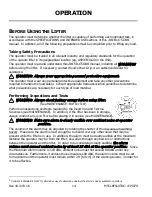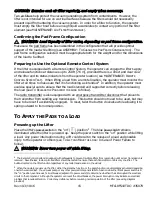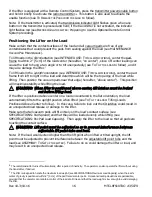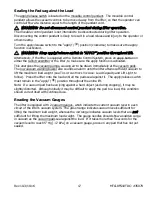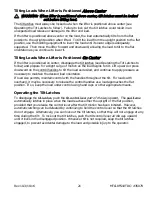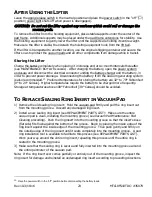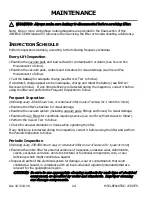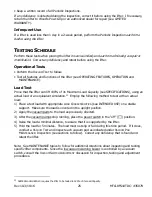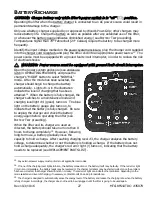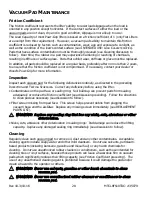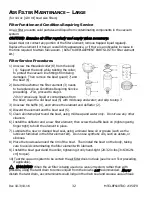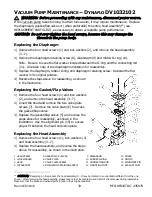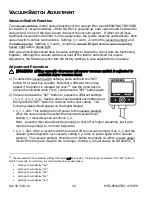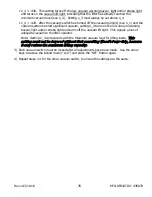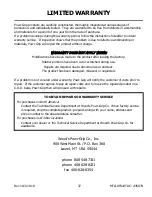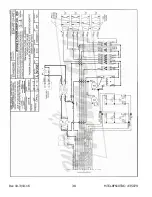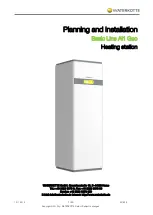
Rev 10.3/10-16
28
MTCL8FS10TDC: #35079
V
ACUUM
P
AD
M
AINTENANCE
Friction Coefficient
The friction coefficient represents the lifter's ability to resist load slippage when the load is
oriented in any position except horizontal. If the contact surfaces of either the load or the
vacuum pads are not clean, dry and in good condition, slippage is more likely to occur.
The Load Capacity of most Powr-Grip lifters is based on a friction coefficient of 1 (only Flat Lifters
are exempt from this requirement). However, a vacuum pad's ability to maintain this friction
coefficient is reduced by factors such as contamination, wear, age and exposure to sunlight, as
well as the condition of the load's contact surface (see INTENDED USE: L
OAD
C
HARACTERISTICS
).
Pads that have surface contamination must be thoroughly cleaned (see Cleaning discussion to
follow). Over time, the rubber in a pad may experience hardening or leaching of chemicals,
resulting in stiffness or surface glaze. Pads that exhibit wear, stiffness or glaze must be replaced.
In addition, all pads should be replaced on a regular basis, preferably after no more than 2 years,
to ensure that the friction coefficient is not compromised. If necessary, contact your dealer or
Wood's Powr-Grip for more information.
Inspection
Inspect each vacuum pad for the following deficiencies routinely, as directed in the preceding
I
NSPECTION
and T
ESTING
S
CHEDULES
. Correct any deficiency before using the lifter.
• Contaminates on the pad face or sealing ring: Soil build-up can prevent pads from sealing
adequately or reduce the friction coefficient (see discussion preceding). Follow the directions
to clean pads as necessary (see discussion to follow).
• Filter screen missing from pad face: This screen helps prevent debris from plugging the
vacuum hose and the air filter. Replace any missing screen immediately (see REPLACEMENT
PARTS LIST).
WARNING: Replace any sealing ring that has any nicks, cuts, abrasions or other
deterioration.
• Nicks, cuts, abrasions other deterioration in sealing rings: Pad damage can reduce the lifting
capacity. Replace any damaged sealing ring immediately (see discussion to follow).
Cleaning
Regularly clean each vacuum pad to remove oil, dust and any other contaminates. Acceptable
cleaning agents include soapy water and other mild cleansers. Do
not use solvents, petroleum-
based products (including kerosene, gasoline and diesel fuel) or any harsh chemicals for
cleaning. Do
not use unauthorized rubber cleaners or conditioners, such as those intended for
cleaning tires or vinyl surfaces, because those products can leave a hazardous film on vacuum
pads which significantly reduces their lifting capacity (see Friction Coefficient preceding). The
use of any unauthorized cleaning agent is prohibited because it could damage the pad and/or
create a hazard to the operator or others.
WARNING: Never use solvents, gasoline or other harsh chemicals to clean
vacuum pad.
WARNING: Never use unauthorized rubber cleaners or conditioners to clean
vacuum pad.
Summary of Contents for MTCL8FS10TDC
Page 2: ...View Quick Start Guide...
Page 40: ...Rev 10 3 10 16 38 MTCL8FS10TDC 35079...
Page 41: ...Rev 10 3 10 16 39 MTCL8FS10TDC 35079...
Page 42: ...Rev 10 3 10 16 40 MTCL8FS10TDC 35079...
Page 43: ...Rev 10 3 10 16 41 MTCL8FS10TDC 35079...
Page 44: ...Rev 10 3 10 16 42 MTCL8FS10TDC 35079...

